Sometimes the sound of flowing water is just what the doctor ordered. Whether you’ve just returned home from work or have been busy pulling weeds in the hot sun, a backyard water garden makes for a luxurious respite — if it doesn’t create headaches of its own. Water gardens have a reputation of being high-maintenance projects with a hundred things that can go wrong. There’s some truth to that stereotype, but there are a few easy things you can do to avoid the pitfalls.
Whether you’re envisioning a grand pond with a waterfall or a simple fountain, understanding aquatic ecology will help you create a water feature that is both functional and beautiful.
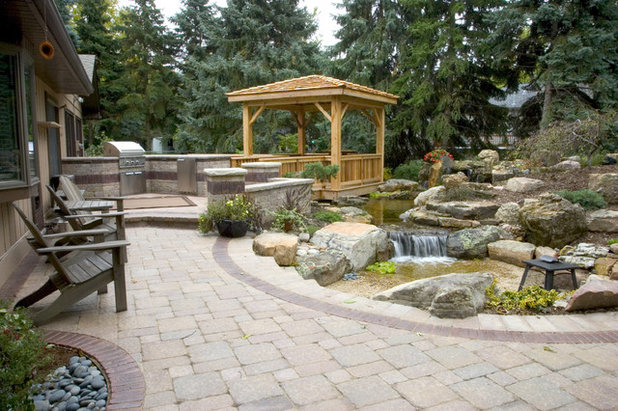
Aquascape
Design it as nature would. This rule applies to both functional and visual aspects of water gardens. Aesthetically, it’s always best to use your landscape’s natural topography. Artificial hills with waterfalls tend to look gaudy, but a water course that follows a path water might naturally take, with ripples and small cascades in steeper areas and broad pools in natural low spots, makes a water feature look like it has been there all along.
This example even incorporates a small sandy beach with pebbles and small boulders around it — things found in any mountain stream.
Learn more about designing a realistic creek bed
 Create a diverse aquatic habitat.
Create a diverse aquatic habitat. Different aquatic plant types live in water at various depths. And each type of plant — marginal, emergent, submerged and floating — has a unique ecological role to play. Having some from each category is one of the keys to maintaining a balanced water chemistry and avoiding turbidity (murkiness), algae buildup and other problems that can turn your sanctuary into a cesspool.
Here are the different plant categories with an example for each:
- Marginal (0 to 12 inches in depth): Cattails (Typha spp)
- Emergent (12 to 24 inches in depth): Water lilies (Nymphaea spp)
- Submerged (24 to 36 inches in depth): Marsh mermaid (Proserpinaca palustris)
- Floaters (live on the surface; the water can be any depth): Duckweed (Lemna spp)
The easiest and most convenient way to provide habitat for the four plant types is to build aquatic benches, or planting strips, at the right depth for each plant type. This will also help to contain them in the specific part of the pond were you want them, so they don’t become unruly.
Above is a photograph of a natural swimming pool, which is a hybrid of a pond and a pool. Aquatic plants are used to keep the water clean, rather than chemicals.
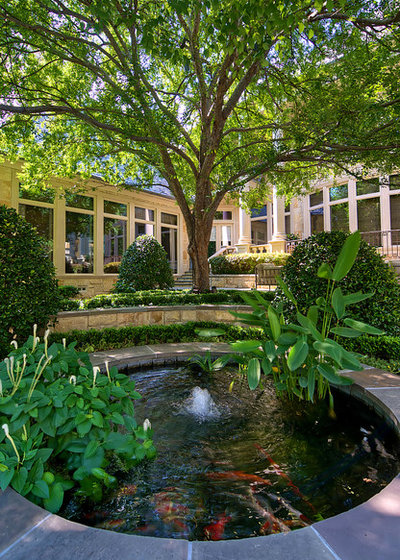
Harold Leidner Landscape Architects
Add shade and aeration. Shade is a big part of what will make you happy when you’re sitting by your pond in the summer. It also contributes to clear, clean water. Algae growth is driven by the sun; the more shade you have, the less likely your water will turn green.
Stagnant water is another enemy of a healthy aquatic ecosystem. The more you use waterfalls, fountains, bubblers and aerators to keep the water moving, the better. Oxygen feeds the aquatic life cycle, ensuring that decomposing plant matter breaks down readily so it doesn’t cloud up the water.
For a small, symmetrical pond like this one, a single bubbler in the middle is sufficient. For larger ponds with a waterfall on one side, be sure to position the pump on the opposite side to create flow throughout the pond, ensuring that the oxygen is evenly distributed. Filtration devices are typically installed just above the waterfall, so the water is simultaneously cleaned and aerated.
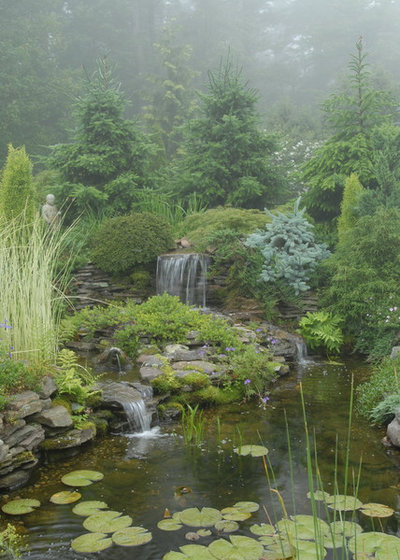
James R. Salomon Photography
The downside of using a large tree to shade your pond is that you’ll have to periodically remove the debris that falls from it. Garden ponds benefit from a few fallen leaves and twigs, because small bits of organic matter are a natural part of any aquatic ecosystem. It’s mainly during the few times of year when large quantities of leaves, nuts, seed capsules and other bits of tree litter drop that you want to be diligent about removing them. Always check a pond after windy weather to see if it has become clogged with debris.
Floating plants, such as the lily pads pictured here, are another way to shade ponds in full sun. Pond experts generally recommend that two-thirds of the water surface be covered in vegetation to prevent the buildup of slimy algae.
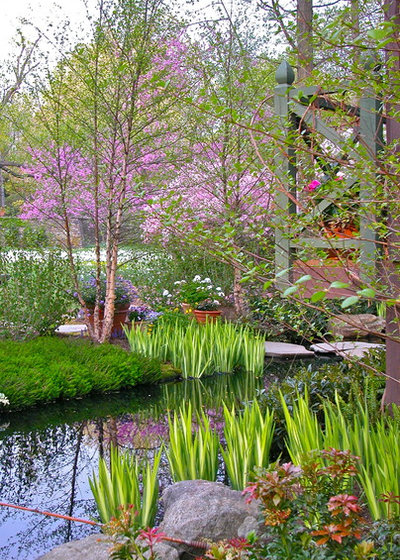
Liquidscapes
Blur the edges. The visible edge of a rubber or plastic pond liner completely spoils the beauty of a water garden, and there are a couple of tricks to keeping it concealed. One is to create a flagstone lip around the edge of the pond that overhangs the pond liner by an inch or two. You can also do it with plants. Lush riparian vegetation around the edges of a pond will mimic the look of natural water features and will help a water garden blend in with the surrounding landscape. Most emergent species (growing in shallow water) will also grow in moist soil, allowing you to use the same species in and out of the water for a dramatic effect — as we see with the water irises (
Iris laevigata) in this example.
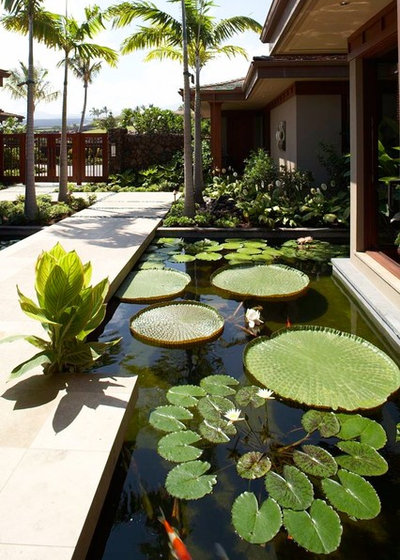
GM Construction, Inc.
Add fish. A pond is not complete without them. They are a necessity for consuming mosquito larvae; they also nibble at algae and help to cycle nutrients, keeping the system in balance. Raising koi takes a bit of diligence, but many pond owners simply stock their pond with gambusia, a tiny minnow-like fish that flourishes with absolutely no attention whatsoever.
Commonly referred to as mosquitofish, these fish live off microscopic organisms in the water, so you don’t need to feed them. If you’re going to use koi or any other fish that needs to be fed, avoid overfeeding at all costs — you’re guaranteed to foul the water. The rule of thumb is to provide only the amount of food that the fish will consume within 15 minutes.
Build a Backyard Fish Pond Without Going Belly Up
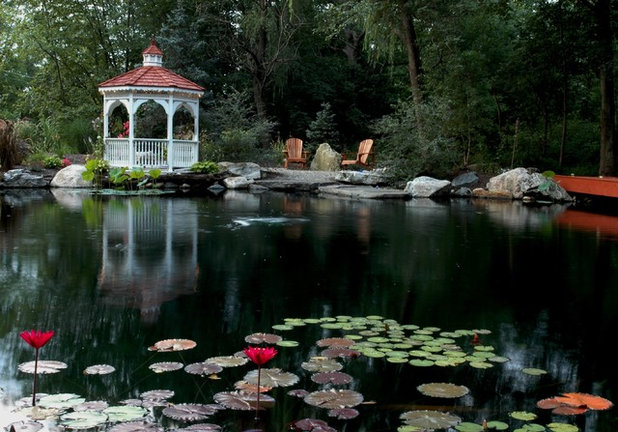
Aquascape
Interact and observe. Water gardens are living systems that change over time, so make sure you create a comfortable spot for hanging out and observing what goes on — the pond will tell you what it needs once you learn to tune in to it.
Keep in mind that it’s a dynamic system, and there is usually no instant fix if something goes wrong. For example, if the water turns to green soup all of a sudden in midsummer, don’t panic — the explosion of algae can only last so long before the nutrients that are feeding it are consumed. Instead, step back and ask yourself what the pond needs so the same problem doesn’t recur again next year.
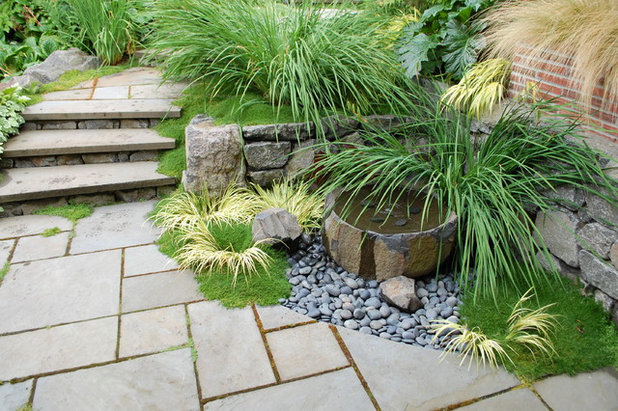
Avalon Northwest Landscape, LLC
Start simple. There is no need to bite off more than you can chew. A small fountain makes a greater starter pond, giving you the ambience you’re looking for without the worry of what might go wrong. While you’re out there enjoying it, read a book or two on pond design and maintenance. There is no point in feeling stressed or worried about it. Just educate yourself as best you can and then take on only what you can comfortably handle.





